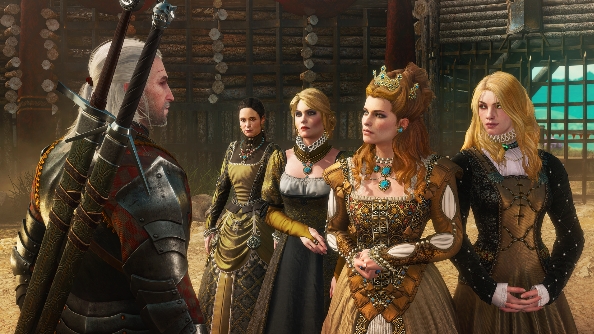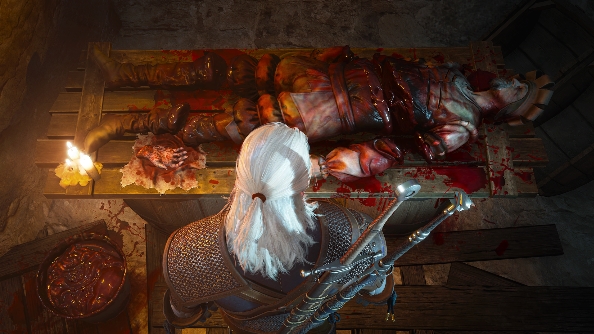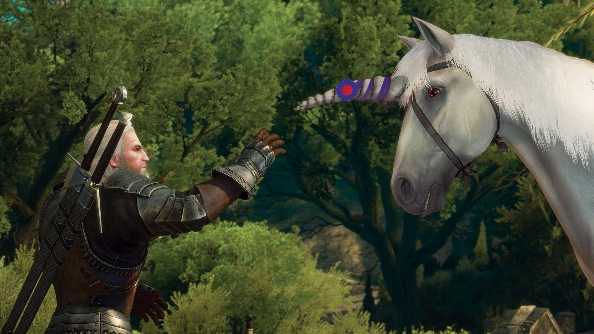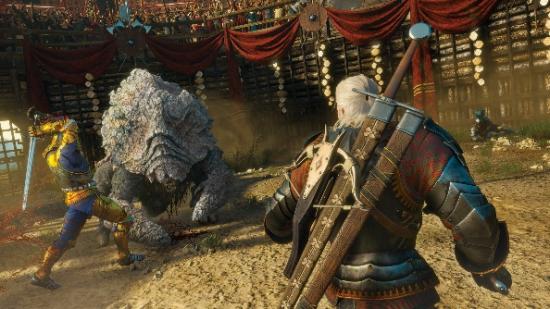Toussaint is unlike anywhere you’ve been in The Witcher before. Typically we’re used to Geralt trekking through dismal bog lands and villages filled with the kinds of locals whose real-life equivalents may be found in the grimmest pubs you could ever mistakenly enter. Toussaint, on the other hand, is a Mediterranean-like haven of warm, autumnal colours, flourishing farmlands, and knights with strict codes of honour.
Oh, and a monstrous serial killer on the loose. Business as usual for The Witcher, then.
Love The Witcher 3? It’s one of the best PC games, for sure.
I recently went to visit CD Projekt at their base in Warsaw to get nice and familiar with Blood & Wine, the second and final expansion for The Witcher 3. Unsurprisingly it’s wonderful; very much more of what you love, with the odd tweak here and there to make sure it’s all smooth and shiny. But it’s the world that CD Projekt have created in Toussaint that makes Blood & Wine special. More so than the likes of Velen and Novigrad, this new country has its own distinct texture and flavour.
I’ve already mentioned the colour palette, which makes the whole thing feel notably more hopeful than the oft-depressing quests of the main game, and that extends into the scenery. The forest floors sprout giant mushrooms, granting the area a slightly more fantastical vibe. Vistas present acres and acres of rolling gold fields, penned in by astonishing mountains that cast shade over towns with a lively Tuscan aesthetic.
The inhabitants of Toussaint are different, too. While there’s no shortage of people with various motives, the population here are more noble than the backstabbers and grudge-holders we’ve become accustomed to. Led by the well-regarded Duchess Anna, it’s a realm of knights who abide by the laws of chivalry; where breaking those rules is akin to blasphemy. Expect to see ever more elaborate armour designs during your trip, with breastplates adorned with sigils and gold leaf, as well as a full-blown medieval-style tournament.

Before all that though, there’s the issue of Golyet the giant. As Geralt gallops into Toussaint on the back of Roach, he’s soon intercepted by a lumbering giant swinging what appears to be a grindstone bolted to a lamppost. Blood & Wine’s first boss battle is a strong indicator of what’s to come over the course of the expansion.
The series of bosses I fought over three hours of play were significantly more challenging than anything from Wild Hunt. Use of the Bestiary is practically mandatory now; while many previous encounters have allowed you to overcome challenges with unrelenting brute force, there are enemies this time that demand use of specific potions and explosives to defeat them, none of which the game will inform you of outside the bestiary. Research is as key to the fight as swinging a sword.
Golyet isn’t that kind of boss, but the encounter with him is exceptionally cinematic. While Blood & Wine doesn’t feel the need to tell another here-comes-the-apocalypse story (it actually feels like Geralt is winding down a little), its biggest battles do feel more event-worthy than many of Wild Hunt’s. Golyet stamps his way through herds of fleeing sheep and causes a windmill to collapse as he bellows and growls, marking his presence as an important and memorable moment in the story.

Not that he’s the main star or antagonist. As mentioned earlier, there’s a serial killer on the prowl, which gives the whole expansion a sort of CSI: Toussaint angle. While Geralt is no stranger to using Witcher sense and plenty of conversation to bring clues and evidence to the surface, this investigation pulls a few more threads from the world of murder mystery fiction. The killer has a distinct MO, butchering very specific people on very specific days. If you wanted a Sherlock Holmes game where you can simultaneously investigate clues and hack the head off a vampire, then Blood & Wine is the game for you.
Should delving into the gruesome details of serial murder be a little too much for your stomach, you can break up your detective work by exploring the new region and its many, many side-quests. Once again this is an area that rivals the scope of anything in the main game, densely populated with villages, outposts, and weird sites of interest that each have something to keep Geralt busy. There’s even a vineyard for the Witcher to tend to during his downtime.

The side-quests are where much of Toussaint’s flavour can be extracted, with one that I was able to play focussing very much on the code of chivalry that everyone seems to abide by. With a knight unable to enter the grand tourney, it’s up to Geralt to brandish his sword in the arena. While the stakes may still be high, there’s an enjoyable sense of joviality to it all. As you practice for the big day – racing horses, making sure your crossbow aim is true on the range – the spirit of the tournament builds. It’s not to say that Blood & Wine is a lighter or simpler story than its siblings, but there’s definitely a feeling that the title of the expansion sums up the two sides you’ll find.
After dozens of hours in the grim, ugly land of Wild Hunt, the trouble-in-paradise world presented in Blood & Wine feels like the perfect epilogue chapter. It’s very much the game we know and love, but presented through a new filter that reminds us that CD Projekt are at their best when they’re offering a fun, alternate turn on the traditional. If this is Geralt’s last hurrah, it seems guaranteed to be one of his finest.
The Witcher 3: Blood & Wine will release May 31.
